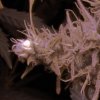Very interesting, tom. Have you a O2/CO2 evolution measurement device? That would be the esential part to know for sure what happen with photosynthesis (photomorphogenesis can be studied by just observing).
Apart of quantum efficiency, that is clear is very similar on all the orange-yellow range (acording to McCree, 100% from 599 to 635nm, and 90% from 559 to 674nm, that already includes all the yellow), we have to take into account differential absorbance. Quantum efficiency refers to already absorbed photons. Its clear that once absorbed, most photons into PAR have a similar ability to perform photosynthesis. But absorbance is higher on blue, that just compensates its lower quantum efficiency, and on red, higher as longer the red wavelenght (up to 670nm or a little higher, specie dependent but always on same trend. So when you examine both the quantum efficiency and absorbance, as Inada did, you get that the max efficiency point is about 670nm, although its over 90% from 600 to 685nm.
When we are growing with artificial light sources, another consideration is very important: how many photons you get with 1 burned watt. In this plays a role mainly the energy efficiency of the source, but too the wavelenght, as at equal energy efficiency, a 660nm emits about 4-5% more photons than a 640nm one, and way more if we talk of shorter red wavelenghts. So if we could get 660nm LEDs with same efficiency than 635nm ones, that until now has been impossible, it could makes sense to use them over any other wl of red.
Now manufacturers are doing AlIngap 660nm LEDs with similar efficiency than standard 625nm dominat wl red LEDs, is the moment to study what is better (until now, clearly the more efficient 640nm peaked, IMO). In this sense, not only photosynthesis matter, as tom pointed out very well. Ive observed too problems when too much 660 red is used.
We need to observe the sinergies of different bands of light, that some may be specie specific and some valid for all. Ive noticed a wide variation of spectrum efficacy (yield per mol of photons), accounting for up to 200%, that clearly cant be explained by different photosynthesis rate of the indivudual bands, but for sinergistic effect between them. And I suspect too that plant acclimatation to light qualities is important.
On the other hand, almost all studies refer to level of light of unsaturated photosynthesis, while on indoor growing usually saturating irradiance levels are used. Things change in this scenario. For sure blue photons are way better on high irradiances than the charts for non saturating photosynthesis may lead to think.
BTW, tom, your data about LED's efficiency is very outdated. Right now there are royal blue LEDs with efficiencies past 50%, and easy to get over 40% ones. Whites with higher efficiencies than HPS (and without taking into account reflector losses) and reds too. The efficiencies you posted were from 2-3 years ago, at least.
 I wasnt worry but now I am happy.
I wasnt worry but now I am happy. I wasnt worry but now I am happy.
I wasnt worry but now I am happy.






